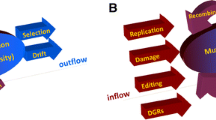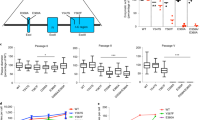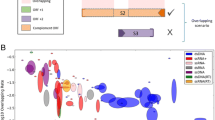Summary
Segmental genomes (i.e., genomes in which the genetic information is dispersed between two or more discrete molecules) are abundant in RNA viruses, but virtually absent in DNA viruses. It has been suggested that the division of information in RNA viruses expands the pool of variation available to natural selection by providing for the reassortment of modular RNAs from different genetic sources. This explanation is based on the apparent inability of related RNA molecules to undergo the kinds of physical recombination that generate variation among related DNA molecules. In this paper we propose a radically different hypothesis. Self-replicating RNA genomes have an error rate of about 10−3–10−4 substitutions per base per generation, whereas for DNA genomes the corresponding figure is 10−9–10−11. Thus the level of noise in the RNA copier process is five to eight orders of magnitude higher than that in the DNA process. Since a small module of information has a higher chance of passing undamaged through a noisy channel than does a large one, the division of RNA viral information among separate small units increases its overall chances of survival. The selective advantage of genome segmentation is most easily modelled for modular RNAs wrapped up in separate viral coats. If modular RNAs are brought together in a common viral coat, segmentation is advantageous only when interactions among the modular RNAs are selective enought to provide some degree of discrimination against miscopied sequences. This requirement is most clearly met by the reoviruses.
Similar content being viewed by others
References
Ahmed R, Fields BN (1981) Reassortment of genome segments between reovirus defective interfering particles and infectious virus: construction of temperature sensitive and attenuated viruses by rescue of mutations from DI particles. Virology 111:351–363
Bancroft JB (1972) A virus made from parts of the genomes of brome mosaic and cowpea chlorotic mottle viruses. J Gen Virol 14:223–228
Both GW, Bellamy AR, Street JE, Siegman LJ (1982) A general strategy for cloning double-stranded RNA: nucleotide sequence of the Simian-II rotavirus gene. Nucleic Acids Res 10:7075–7087
Bromley PA, Barry RD (1973) Characterisation of the RNA of fowl plague virus. Arch Gesamte Virusforsch 42:182–196
Domingo E, Sabo D, Taniguchi T, Weissman C (1978) Nucleotide sequence heterogeneity of an RNA phage population. Cell 13:735–744
Drake JW (1974) The role of mutation in microbial evolution. Soc Gen Microbiol Symp (Cambridge) 24:41–58
Eigen M Schuster P (1977) The hypercycle. A principle of natural self-organization. Part A: Emergence of the hypercele. Naturwissenschaften 64:541–565
Greenberg HB, Wyatt RG, Kapikian AZ, Kalica AR, Flores J, Jones R (1982) Rescue and serotypic characterisation of noncultivable human rotavirus by gene reassortment. Infect Immun 37:104–109
Haber S, Ikegami M, Bajet NB Goodman RM (1981) Evidence for a divided genome in bean golden mosaic virus, a geminivirus. Nature 289:324–326
Habili N, Francki RIB (1974) Comparative studies on tomato aspermy and cucumber mosaic viruses. III. Further studies on the relationship and construction of a virus from parts of the two viral genomes. Virology 61:443–449
Holland J, Spindler K, Horodyski F, Grabau, E, Nichol S, Vande Pol S (1982) Rapid evolution of RNA genomes. Science 215:1577–1585
Inoue T, Orgel LE (1983) A non-enzymatic RNA polymerase model. Science 219:859–862
Jaspers EMJ (1974) Plant viruses with a multipartite genome. Adv Virus Res 19:37–149
Joklik W (1974) Evolution in viruses. Soc Gen Microbiol (Cambridge) 42:293–320
Joklik W (1981) Structure and function of the reovirus genome. Microbiol Rev 45:483–501
Kornberg A (1980) DNA replication. WH Freeman and Co, San Francisco, p 724
Lane LC (1979) The RNAs of multipartite and satellite viruses of plants. In: Hall TC, Davies JW (eds) Nucleic acids in plants, vol 2. CRC Press, Boca Raton, pp 65–110
Loeb AA, Kunkel TA (1982) Fidelity of DNA synthesis. Annu Rev Biochem 51:429–457
Matthews REF (1979) Classification and nomenclature of viruses. Intervirology 12:129–296
Maynard-Smith J (1978) The evolution of sex. Cambridge University Press. Cambridge, England, chapter 1
Min Jou W, Haegeman G, Ysebaert M, Fiers W (1972) Nucleotide sequences of the gene coding for the bacteriophage MS2 coat protein. Nature 237:82–88
Nahmias AJ, Reanney DC (1977) The evolution of viruses. Annu Rev Ecol Systematics 8:29–49
Palese P, Schulman JL (1976) Differences in RNA patterns of influenza A viruses. J Virol 17:876–884
Palese P, Young JF (1982) Variation of influenza A, B and C viruses. Science 215:1468–1473
Portner A, Webster RG, Bean WJ (1980) Similar frequencies of antigenic variants in Sendai, vesicular stomatitis and influenza A viruses. Virology 104:235–238
Prabhakar BS, Haspel MV, McClintock PR, Notkins AL (1982). High frequency of antigenic variants among naturally occurring human Coxsackie B4 virus isolates identified by monoclonal antibodies. Nature 300:374–376
Reanney DC (1982) The evolution of RNA viruses. Annu Rev Microbiol 36:47–73
Reanney DC, Pressing J (1983) Heat as a determinative factor in the evolution of genetic systems. J Mol Evol, submitted
Reanney DC (1984) Genetic noise in evolution? Nature 307:318–319
Reanney DC (1984) The molecular evolution of RNA viruses. Soc Gen Microbiol Symp (Cambridge) 35:175–196
Reijnders L (1978) The origin of multicomponent small ribonucleoprotein viruses. Adv Virus Res 23:79–102
Rogers J, Wall R (1980) A mechanism for RNA splicing. Proc Natl Acad Sci USA 77:1877–1879
Rose M, Doolittle WF (1983) Parasitic DNA—the origin of species and sex. New Scientist 16:787–789
Shannon CE (1949) The mathematical theory of communication. In: Shannon CE, Weaver W (eds) The mathematical theory of communication. University of Illinois Press, Urbana, Illinois
Shatkin AJ, Sipe JD, Loh P (1968) Separation of ten reovirus genome segments by polyacrylamide gel electrophoresis. J Virol 2:986–991
Silverstein SC, Christman JK, Acs G (1976) The reovirus replicative cycle. Annu Rev Biochem 45:375–408
Tinoco I, Uhlenbeck O, Levine M (1971) Estimation of secondary structure in ribonucleic acids. Nature 230:362–367
Webster RB, Granoff A (1974) The evolution of orthomyxoviruses. In: Kurstak E, Maramorosch K (eds) Viruses, evolution and cancer. Academic Press, New York, pp 625–647
Author information
Authors and Affiliations
Rights and permissions
About this article
Cite this article
Pressing, J., Reanney, D.C. Divided genomes and intrinsic noise. J Mol Evol 20, 135–146 (1984). https://doi.org/10.1007/BF02257374
Received:
Revised:
Issue Date:
DOI: https://doi.org/10.1007/BF02257374




